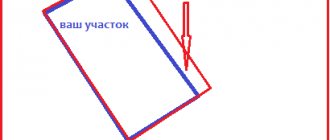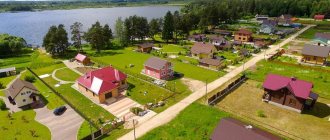What does land provide for settlements?
Land for settlements has its own individual characteristics. First of all, it is located precisely in the places where people live or in their surroundings. This is due to the fact that land for settlements is allocated for people, that is, it is necessary to serve cities, towns and even megacities.
The second feature of settlement plots is a specific border. Basically, land for settlements has the same boundaries as the cities, towns and villages in which it is located. Changing the boundaries of territorial settlements is possible only with the approval of all development plans located in the settlement.
The third feature of land for settlements is that their organization takes place entirely with the participation of the city administration, which acts in accordance with the established planning for construction and other projects.
Transfer of lands into settlement lands
Some types of land plots can be transferred to the category of settlement lands. Most often, these are lands intended for agricultural activities and reserve lands. In exceptional cases, the lands of the water and forest funds are subject to transfer. For example, when a reservoir dries up or a forest is cut down.
However, to make a decision on transferring land from one category to another, the main parameter is the cost of the land. For example, if the cost of a plot is more than 50% higher than the average price of similar areas in the settlement, then it is impossible to transfer it.
A change in category can be made at the written request of individuals or legal entities. In some situations, the decision to transfer land can be made by local authorities if this is required to expand the settlement.
Was the Recording helpful? No 0 out of 1 readers found this post helpful.
How are settlement lands distributed?
The Land Code of the Russian Federation, namely its Article 85, provides for the division of lands for settlement into certain zones, which are intended for:
- Construction of residential buildings.
- Conducting agricultural activities.
- The needs of the Russian Armed Forces.
- Other objects for special purposes.
- Consumer needs of the population.
Each of the listed zones of land settlement has its own regulations, which may have different interpretations. Also, each of them has its own rules, the observance of which is mandatory when developing each territorial object.
The Russian Land Code also states that each owner of a land plot is obliged to adhere to the basics of the established land layout for settlements, as well as the rules for carrying out any construction work.
IMPORTANT !!! Each building under construction must correspond to the correct zone, but it is also worth considering that some zones may intertwine with each other, which in turn directly affects the type of permitted use. That is why, before you start using land for settlement, it is necessary to look and study their scheme in detail, and take into account all the norms and rules established by the legislation of the Russian Federation.
All plots that are located on the territory of lands for settlements are divided into several types, according to the following features:
- Can they be privatized? Such land plots can become private territories, but some of them are still prohibited from privatization by law. As a rule, public places are prohibited: parks, roads, rivers, etc.
- What type of operation is acceptable? If two areas are intertwined, then their use also becomes mixed. In this case, priority is given to the more serious object. For example, an area of land for settlement is marked in one of the state construction plans, and is designated for general use. As a result, sooner or later the state will seize its land, and it is useless to start construction on such a site.
- What are they intended for? As a rule, such plots belong exclusively to individuals, for example, dachas, personal housing or gardens.
The legislative framework
Settlement lands are prescribed in the Land Code of the Russian Federation.
In this document, a whole section is dedicated to them - 15. like this:
- Art. 83 - defines the very concept of “settlement land” and the order to which their definitions and zoning are subject.
- Article 84 - gives characteristics regarding the establishment of the boundaries of such a settlement. And how it should be established, who installs and determines it.
- Art. 85 - describes the composition of these lands and territorial zoning, rules and regulations for urban planning.
- Article 86 - determines the composition of natural zones, their boundaries and rules of use.
What are settlement acres made of?
All plots that are classified as land for settlement are intended for purposes other than other groups of land plots.
Today, settlement sites are of the following types:
- Social. Allotments on the territory of which buildings of government organizations or non-profit companies are located;
- Commercial. Allotments on the territory of which buildings for production are located: canteens, markets and other facilities necessary for the activities of individual entrepreneurs;
- Housing. These are considered plots that will be used for the construction of multi-storey buildings for housing, as well as the construction of cottage houses and country houses.
There are also other types of plots located in territories for settlements that do not fall under a specific category, and among them are the following:
- Areas without which it is impossible to carry out road traffic and various communications;
- Areas classified as natural and which need to be protected;
- Sites with historical as well as cultural essence;
- Areas that are included in the forest fund;
- Areas on the territory of which natural water pools are located: rivers, lakes, waterfalls, etc.;
- Areas intended for public life of people;
- Plots classified as reserves, without which the development of populated areas and economy is impossible;
- Areas with special purposes.
All of the listed types of sites are inextricably interconnected, even despite the fact that each of them is intended for different needs. Both are vital for each populated area to develop.
Conditions for the provision of plots from settlement lands
All aspects when obtaining a plot on settlement lands for the construction of a residential building, its dimensions, communications, external design are stipulated in the purchase and sale or lease agreement. Only after receiving such permission can you begin to build a house on the purchased site. A necessary condition is that it must comply with urban planning standards.
There are lands within the boundaries of settlements that are difficult to obtain, since there is a high demand for them, and therefore the cost is high. Such settlements include the Moscow and Leningrad regions, as well as the Republic of Crimea.
However, there are also places where land for development can be obtained almost free of charge, for example, in sparsely populated cities or in the north.
The size of a plot that can be provided for use or transferred as private property is determined by the purpose of its use and the established standard in force at the time of the applicant’s application. You need to indicate that these are the dimensions of the land plot you need for your specific needs. Usually there are no problems with this, and all that is necessary is to write an application to the local authority.
How can you turn a plot for gardening into a plot for individual housing construction and what is this individual housing construction?
The Russian government has given people who have a plot of land for gardening the opportunity to transfer it to individual housing construction. Already from the 1st day of this year, all gardeners who wish have the right to build a house for living on their site, and even some outbuildings. In order to begin construction, first of all, you need to document your right to carry out construction work.
Required documents:
- Papers indicating the right to own land;
- An extract from the cadastral organization stating that the site can indeed be used for individual housing construction;
- Technical documents with information about the new building;
- A document confirming that the land was used for gardening.
In some situations, additional documents may be required, depending on the characteristics of the land and what types of permitted uses it has.
Zoning of land in settlements
Territorial zoning of settlements Land zoning is the division of the territory of a settlement into areas that have different purposes and the corresponding legal regime of use. Zoning is carried out in accordance with the approved plan for the development of the settlement. The regulations on zoning and its basic principles have been approved by the Government of the Russian Federation. The decision to carry out zoning is made by an administrative document of a territorial government body or a decision of a local government body. Residential zones include land plots that are intended for individual and public residential development, as well as the construction of cultural, social and social facilities. Real estate located in a residential area can be represented by individual residential buildings, low-rise, mid-rise and high-rise buildings. In addition to residential buildings, other types of development may be located according to the urban planning plan. Most of the territories of settlements are allocated for housing development, which corresponds to the intended purpose of the category of lands of settlements. However, populated areas cannot exist without administrative buildings, educational, cultural, and social facilities. Therefore, such objects are also included in urban planning plans for the development of residential areas of settlements. A certain part of the land in settlements is allocated for industrial development, utility and warehouse facilities, engineering and transport infrastructure. Such facilities have sanitary protection zones to ensure the safety of residents of the locality. The improvement of such areas is carried out by the owners of production facilities at their own expense. The legal regime of lands in settlements, which provides for urban zoning, is provided for by land and urban planning legislation.
Planning the development of the territory and establishing land use rules is carried out for the following purposes: to create conditions for the sustainable development of the territorial municipality; preservation of the environment and objects that are classified as cultural heritage monuments; planning the boundaries of the administrative territory of a settlement; proper provision of the rights of owners of land plots and protection of their interests in the use of plots and buildings and structures located on them; creating a favorable investment climate by providing a wide choice in the use of allocated land, as well as objects related to capital construction.
The rules for land use and development of the territory of a populated area, approved by the relevant body of state power or local self-government, provide for the procedure for their application and the introduction of appropriate changes to them. An integral part of these standards are: urban zoning map; town planning regulations; regulations on regulation of land use and development by local governments; the procedure for changing the types of permitted use of land plots and capital construction projects; regulations for the preparation of territory planning documentation; the procedure for holding public and public hearings on issues related to the procedure for land use and land development; the procedure for making appropriate changes to land use rules. Other issues that require consideration may also be included. Approved boundaries are drawn on the urban zoning map according to territorial zones. Moreover, each land plot can belong to only one territorial zone, which is reflected in the corresponding boundaries.
Composition of lands in settlements In accordance with the provisions of Article 7 of the Land Code of the Russian Federation, lands related to settlements are included in the lands of the entire country. In accordance with the law, lands that are used and intended for development are included in the lands of settlements, since according to their intended purpose they are intended for the development of settlements. In accordance with the provisions of Articles 85 of the Land Code and 35 of the Town Planning Code, land plots that constitute the lands of settlements may belong to the following territorial zones provided for by town planning regulations: residential territorial zones; public and business territorial zones; production territorial zones; intended for engineering networks and transport infrastructure; related to recreational zones; used in agricultural production; having the status of special purpose zones; intended for the placement of military facilities; belonging to other territorial zones. Residential zones include land plots that are intended for the construction of residential buildings, as well as cultural and community facilities.
In residential areas, both individual and industrial residential construction is possible. Moreover, in both the first and second cases, residential development can be represented by low-rise, mid-rise and high-rise buildings. Town planning regulations may also provide for other types of development related to the implementation of the housing program. In public and business zones, land plots are used for the construction of administrative buildings and facilities intended for use in the fields of education, culture, and everyday life. In addition, buildings for public use can be erected on this category of land, which is also provided for by the town planning regulations. Industrial zones include land plots on which construction is carried out with buildings for industrial and municipal purposes, warehouses, as well as other buildings that are specified in the town planning regulations. The engineering and transport infrastructure zones include land plots on which the following facilities are located: railways; road, river, sea and air transport; pipeline transport; communications; engineering infrastructure. It may also include objects that have a different purpose, but are included in the town planning regulations. The lands that are included in recreational zones include land plots on which there are urban forests, public gardens, parks, urban gardens, ponds, lakes, reservoirs, as well as those used for recreation by city residents and tourists. Land plots located within the boundaries of a populated area include specially protected areas containing objects of environmental, scientific, historical, cultural, aesthetic, recreational, health and other particularly valuable significance. In some settlements there are zones with land plots that have agricultural purposes. Such lands, in accordance with the master plans of settlements, are used for arable land, perennial plantings, buildings and structures that are intended for agricultural production. A separate category of lands in settlements consists of land plots that are intended for use in general. They contain squares, streets, passages, squares, boulevards, water bodies, beaches and other objects that are not subject to privatization. Boundaries of territorial zones in populated areas All territorial zones of land in a populated area are outlined on an urban planning map. The regulations, which are an integral part of the urban planning map, indicate all types of permitted land use, their maximum sizes, as well as restrictions that are established in relation to specific land plots or territorial zones. The town planning regulations specify the legal regime of land plots in a settlement. The legal regime does not apply to all lands of a settlement. Its scope does not include lands occupied by cultural heritage sites, areas of public places, and those located under linear objects. At the same time, the requirement is observed that a land plot of a certain territorial zone cannot be part of another territorial zone.
At the initial stage of development of a settlement, the requirements of urban planning regulations may not be observed, since at this stage it is almost impossible to identify separate territorial zones with the same type of use. Therefore, in the future, within the boundaries of the territorial zone, areas may appear that were used in accordance with the requirements of the current legislation, however, after zoning, they began to not comply with the requirements of urban planning regulations.
Purpose of settlement territories
The purpose of settlement lands is a certain territorially fixed platform for the distribution within it of housing, production workshops, office buildings, social cultural centers, and structures that are intended for the consumer needs of the population.
The significance and economic benefit of settlement areas is determined by completely different indicators, in contrast to territories of other categories. The assessment of these sites directly depends on their location, terrain, the presence or absence of any buildings, communications, as well as the state of the ecological environment.
Definition
The rules of land use and development also include urban planning regulations, which define the principles of construction in a certain territory, as well as the maximum standards for the construction and placement of objects.
The need and basic requirements for the content of the PZZ are determined by the Town Planning Code. The document was adopted on December 29, 2004 after the signing of No. 190-FZ. The current edition was approved on April 24 of this year.
Article 30 of the Civil Code of the Russian Federation is directly devoted to PZZ. It details the purpose of developing the document, the information required to be included, and the procedure for making changes.
The development of rules is carried out by local governments, which is a requirement of No. 131-FZ, approved on October 6, 2003. The federal law defines the principles of functioning of local governments in Russia. Responsibility for drawing up the PZZ is established by Article 14 No. 131-FZ. The procedure for developing the document is also determined by local authorities. As an example, the PZZ of the city of Moscow is posted on the official portal of the Mayor of the capital and is freely available.
Residential land use
A private person, as a rule, may be interested in purchasing plots from two categories of territorial units. These include agricultural and residential areas. This is due to the fact that the remaining categories are not intended for registration of land ownership by a private person.
Thus, according to the law, these categories of land in residential zones can be used for a number of purposes, namely:
- Residential construction on an individual basis.
- Construction of residential buildings of different heights.
- Construction of premises for cultural and domestic purposes.






